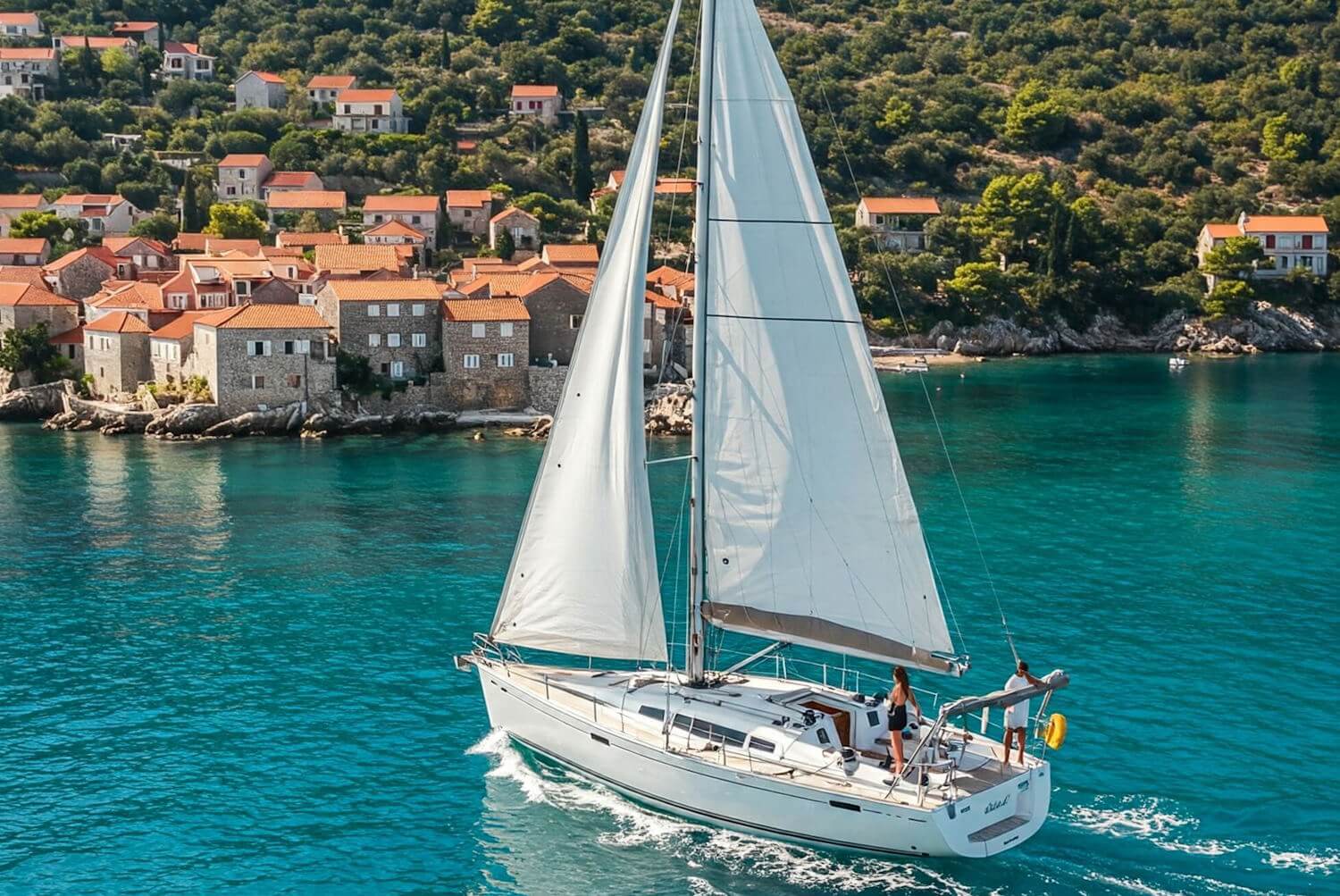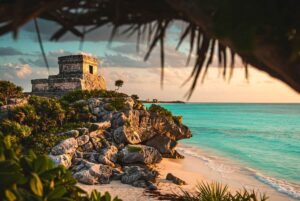Introduction to Croatia’s Adriatic Coast
The Croatian Adriatic Coast is a breathtaking expanse that combines natural beauty with rich cultural heritage, making it one of the most sought-after sailing destinations worldwide. Stretching over 1,700 kilometers, this coastline is dotted with numerous islands, each boasting unique charms and landscapes, creating an idyllic environment for island-hopping adventures. The azure waters of the Adriatic Sea, coupled with a temperate climate, form a perfect backdrop for sailing enthusiasts and nature lovers.
Among the most notable islands are Hvar, known for its vibrant nightlife and historical architecture, and Korčula, famous as the birthplace of Marco Polo. These islands offer visitors a glimpse into the diverse history of the region while showcasing stunning beaches, olive groves, and vineyards. Coastal towns such as Dubrovnik, often referred to as the “Pearl of the Adriatic,” provide a mixture of medieval history and contemporary culture, enhancing the overall experience of exploring this magnificent coastline.
The geography of the Croatian coast is characterized by a series of rugged cliffs, secluded coves, and gently rolling hills dotted with charming villages. Sailing along this splendid coast not only allows for exploration of hidden gems but also provides the opportunity to enjoy local culinary delights, traditional music, and vibrant festivals. Each island presents a unique culture and atmosphere, offering diverse experiences that cater to both adventure seekers and those looking to unwind.
With its captivating landscapes, rich traditions, and welcoming atmosphere, Croatia’s Adriatic Coast stands out as a premier sailing destination. The allure of island-hopping in this region encapsulates an adventure unlike any other, inviting sailors and travelers alike to embark on a memorable journey through the heart of the Adriatic.
Best Time to Sail in the Adriatic
When planning a sailing adventure along the Croatian coast, understanding the best time to sail is paramount. The sailing season in the Adriatic typically spans from late April to October, during which the weather is most favorable for cruising. However, each season offers distinct advantages and disadvantages that can significantly affect the overall experience.
The peak summer months of July and August attract a substantial influx of tourists. During this period, the weather is predictably warm, with average temperatures hovering around 30°C (86°F). The idyllic conditions, characterized by calm seas and ample sunshine, make this time a paradise for sailors. However, the popularity of these months leads to crowded harbors and higher marina fees, which can detract from the overall sailing experience. It is advisable for those choosing to sail during this time to book accommodation and moorings well in advance.
Alternatively, the shoulder seasons of late spring (May and June) and early autumn (September and early October) present a compelling case for many sailors. During these months, the weather remains pleasant with fewer tourists, allowing for a more tranquil sailing experience. Sailing enthusiasts can enjoy a more relaxed atmosphere in the harbors and greater availability of services. Additionally, local events such as festivals and regattas often occur during these times, providing an authentic cultural experience. However, sailors must be prepared for variable weather conditions and occasional winds that can occur during the transition periods.
Ultimately, the best time to sail in the Adriatic depends on personal preferences regarding weather, crowd levels, and desired activities. By considering these factors and planning ahead, sailors can ensure a more enjoyable and memorable journey through the stunning Croatian islands.
Essential Sailing Tips for Beginners
Sailing the Croatian coast, particularly for beginners, can be an exhilarating experience enhanced by understanding key sailing principles and practices. Safety should always be the foremost priority. Before embarking on your journey, ensure that you have a well-stocked first aid kit on board and familiarize yourself with emergency procedures such as man-overboard protocols and distress signaling. Always adhere to the safety guidelines provided by your charter company or tour operator.
Navigation is another crucial aspect that novice sailors must master. Basic navigation skills include understanding charts and maps, using a compass, and recognizing significant maritime markers. For beginners, investing in a reliable marine navigation app or a GPS device can be enormously beneficial in unfamiliar waters. Equally, keeping an eye on the weather is essential; sudden changes can affect your sailing experience. It is recommended to regularly check local forecasts and be prepared to adjust your plans accordingly.
Regarding essential sailing gear, several items are indispensable for a smooth sailing experience. Wearing a life jacket is a fundamental safety measure, and harnessing a safety line when moving on deck is advisable. Ensure you have appropriate clothing to shield you from wind and sun, such as breathable fabrics and a sun hat. Furthermore, familiarize yourself with the basic operation of the equipment on board, including sails, the rudder, and anchoring gear. Understanding the parts of the boat and how they interact will enhance your capability to manage tasks during your sailing trip.
Ultimately, whether chartering your own boat or participating in a guided tour, possessing a sound understanding of sailing fundamentals will significantly enrich your experience. Engaging with fellow sailors, asking questions, and remaining open to learning will contribute to a memorable journey along the stunning Croatian coastline.
Anchoring and Mooring: A Practical Guide
When sailing along the stunning Croatian coast, understanding the anchoring and mooring options available is essential for a safe and enjoyable experience. The Adriatic Sea, known for its crystal-clear waters and picturesque islands, offers both public moorings and private marinas as anchoring solutions. Each has distinct advantages and challenges that sailors must consider.
Public moorings are scattered throughout the islands, providing accessible and often cost-effective solutions. These moorings usually consist of buoys designated for transient sailors. It is recommended to arrive early during the peak season to secure a spot, as they can become quite crowded. Typically, the local authorities manage these moorings, ensuring a level of safety; however, conditions can vary significantly depending on location and weather. Be prepared to follow local regulations, including payment and time limits, which may differ from one buoy to another.
On the other hand, private marinas offer a more structured option for mooring. They usually provide additional amenities such as water, electricity, and safety services, making them an attractive choice for those who prefer comfort. Reservations in advance during high season are advisable, as marinas can fill up quickly. Thorough research on the marina’s facilities and customer reviews can improve the experience significantly.
When anchoring, it’s crucial to assess the seabed conditions, as many popular spots feature rocky or uneven terrain that can complicate anchoring. Utilize nautical charts and local resources to identify suitable areas and avoid potential hazards. Moreover, communication with fellow sailors can lead to valuable insights about hidden gems.
In conclusion, understanding the anchoring and mooring options in the Adriatic is vital for a successful island-hopping adventure. Whether you choose public moorings or private marinas, being aware of regulations and best practices will enhance your sailing experience along the captivating Croatian coast.
Top Islands to Explore: Must-Visit Destinations
The Croatian coast is renowned for its breathtaking islands, each offering distinct attractions that cater to various travel interests. One of the standout islands is Hvar, acclaimed for its vibrant nightlife and stunning landscapes. Visitors can explore the historic Hvar Town, with its ancient fortress and impressive 16th-century architecture. Wine enthusiasts may enjoy a vineyard tour, while those seeking relaxation can unwind on pristine beaches, such as Dubovica, known for its crystal-clear waters.
Another noteworthy destination is Korčula, often referred to as the birthplace of Marco Polo. This island is rich in cultural heritage, boasting well-preserved medieval architecture, particularly in the town of Korčula. Tourists can engage in traditional sword dances and sample exquisite local wines in vineyards scattered across the island. Korčula’s picturesque beaches and secluded bays also make it ideal for swimming, sailing, and water sports.
Vis, a lesser-known gem, is characterized by its untouched nature and historical significance. Known for its tranquil ambiance, Vis offers opportunities to explore beautiful coves, such as Stiniva, often cited as one of the world’s most stunning beaches. Additionally, the island is home to the Blue Cave, a unique natural phenomenon attracting adventurers and photographers alike. Visitors can indulge in local cuisine at charming seaside restaurants and immerse themselves in the island’s rich maritime history.
Beyond these highlights, numerous other islands deserve exploration, including Brač, the home of the famous Zlatni Rat beach, and the tranquil island of Šolta, perfect for those seeking a quieter escape. Each island on the Croatian coast promises unique experiences, making the journey of island-hopping an unforgettable adventure along the Adriatic.
Culinary Delights: Food and Drink on the Islands
The Croatian coast, with its spectacular scenery and crystal-clear waters, offers not only breathtaking views but also a rich culinary landscape that reflects the region’s diverse heritage. Each island presents a unique array of flavors, waiting to be explored by the discerning palate. Seafood dominates the menu, with fresh catches from the Adriatic, including fish, octopus, and shellfish prepared simply, often grilled or stewed with local herbs and olive oil. This approach to cooking emphasizes the freshness of the ingredients, allowing the flavors to shine without overwhelming them.
Regional specialties vary from one island to another. For instance, the island of Hvar is renowned for its lavender-infused dishes and the exceptional white wine, Plavic Mali, while Vis boasts traditional dishes such as peka – a slow-cooked meal prepared under a bell-shaped lid, usually featuring lamb or seafood. Similarly, Korčula is famous for its kulen, a type of spicy sausage that reflects the island’s rich agricultural background. Dining in konobas, traditional Croatian taverns, proves to be a delightful way to experience local cuisine, often featuring rustic décor and menus that change with the seasons.
In addition to extraordinary traditional dishes, the islands also offer an impressive range of local wines. Dingač and Postup from the Pelješac Peninsula are two noteworthy red wines, deeply cherished by connoisseurs. For those seeking a lighter option, the white wines of Grk and Pošip are equally compelling. Many waterfront restaurants provide excellent pairings of these wines with local seafood dishes, making for an unforgettable dining experience surrounded by the stunning Adriatic landscape. Enthusiasts of food and drink will find the culinary offerings on the Croatian islands to be a true delight, merging tradition with the fresh bounty of the sea.
Water Activities and Adventure Sports
The Croatian coast, with its crystalline waters and stunning landscapes, offers a plethora of water activities and adventure sports that cater to both novice and experienced sailors. Among the most popular activities are snorkeling and scuba diving, which allow enthusiasts to explore the vibrant marine life that thrives in the Adriatic Sea. Numerous dive sites are available, including the underwater caves near Vis Island and the shipwreck off the coast of Pula, where divers can discover an array of fish species and coral formations. For snorkeling, the Pakleni Islands provide a perfect backdrop, with shallow waters and rich biodiversity easily accessible from the coastline.
Paddleboarding and kayaking have also gained popularity among water sports enthusiasts. These activities offer a unique opportunity to glide along the serene waters while taking in the magnificent coastal views. The islands of Hvar and Brač are particularly favored for kayaking, as they feature numerous hidden coves and inlets that are best accessed by small boats. To fully enjoy these experiences, it is recommended to wear a personal flotation device and use sun protection, as conditions can shift rapidly in the Adriatic.
When partaking in any of these water activities, it is crucial to ensure that proper equipment is utilized. Snorkelers should invest in a quality mask and fins, while divers need to have certified gear. Paddleboards and kayaks can often be rented at various harbors, but confirming the condition and safety of the items beforehand is advisable. To maximize enjoyment, sailors should also keep in mind local regulations and guidelines, including respecting marine protected areas and observing environmental responsibility.
Cultural Experiences and Local Events
Exploring the Croatian coast is not solely about the breathtaking views and pristine waters; it also encompasses a profound engagement with the local culture and its vibrant heritage. The Adriatic islands are scattered with opportunities to immerse oneself in traditional festivals, bustling local markets, and historical landmarks that significantly enhance the travel experience.
Throughout the year, several traditional festivals can be found on the islands, showcasing the rich customs and folklore of Croatia. For instance, the Island of Hvar celebrates its St. Stephen’s Day Festival in August, featuring processions, music, and dancing that pay homage to local traditions. Similarly, Korčula hosts the Moreška sword dance each summer, a historical reenactment that highlights the island’s maritime past and warrior heritage. Participating in such events allows travelers to gain a deeper understanding and appreciation for the customs that shape the Croatian identity.
Additionally, the local markets offer an authentic glimpse into everyday life in coastal towns. Markets like those in Split and Dubrovnik brim with fresh produce, artisanal goods, and handmade crafts. Visitors can interact with local vendors and learn about traditional Croatian cuisine through sampling regional delicacies. Engaging with residents not only fosters cultural exchange but also provides travelers a chance to discover hidden gems and local favorites that are often absent from mainstream tourism guides.
Furthermore, historical sites are pivotal to understanding Croatia’s diverse heritage. Iconic locations such as the ancient city walls of Dubrovnik or the Roman amphitheater in Pula stand as testaments to the country’s extensive past. Combining visits to these landmarks with participation in local cultural events creates a holistic experience, allowing travelers to appreciate both the historical and contemporary aspects of Croatian society, enriching their journey along the Adriatic coast.
Conclusion: Planning Your Perfect Island-Hopping Journey
Embarking on an island-hopping journey in Croatia offers a unique opportunity to explore the stunning archipelago of the Adriatic Sea. As we have discussed throughout this post, the key to a rewarding sailing experience lies in thorough planning and personal preference. Whether you gravitate towards vibrant tourist hotspots like Hvar or the tranquil serenity of lesser-known islands, ensuring your itinerary aligns with your interests can significantly enhance your experience.
When crafting your perfect itinerary, consider incorporating a blend of activities. Balance days filled with the excitement of sailing and exploring charming coastal towns with more leisurely experiences. This could entail spending a day sunbathing on one of the pristine beaches or indulging in local cuisine at a seaside restaurant. Furthermore, plan to enjoy various water activities such as snorkeling or diving, as these allow deeper engagement with the rich marine life along the Croatian coast.
Additionally, it is recommended to remain flexible in your schedule. The Adriatic Sea offers spontaneous experiences that can enhance your journey. Unexpected discoveries such as uninhabited islands or local festivals can provide cherished memories. Be open to adjusting your plans, ensuring that your trip remains enjoyable and stress-free. Lastly, always take the weather into account, as conditions can vary significantly and affect sailing plans.
Ultimately, an island-hopping adventure along Croatia’s picturesque coastline requires thoughtful preparation and an open mind. By taking the time to curate a balanced itinerary that reflects your personal interests, you can create an unforgettable vacation that encapsulates the beauty of the Adriatic. So, gather your essentials and set sail; your ideal Croatian island-hopping journey awaits!




